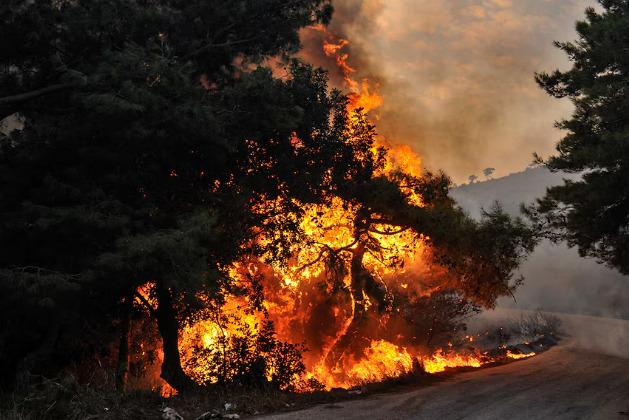
Mediterranean Region (Enmaeya News) — With the rise of catastrophic wildfires worldwide, questions arise about how well damaged ecosystems recover and how long it takes. Historical evidence shows ecosystems can regenerate after fires. However, as wildfire intensity and scale increase alongside climate change, human efforts to support recovery must also intensify.
When witnessing the devastating fires in Syria’s Latakia forests, Turkey, or previously in Southern California, many wonder if complex and diverse ecosystems can bounce back. The short answer: yes. But the process is not simple, and climate change complicates it further.
Naturalists say human intervention is often unnecessary to revive burned forests, as these ecosystems have evolved over millions of years and rely on periodic fires to maintain natural balance.
Studies of historical fires reveal how ecosystems change after fires, benefiting biodiversity and boosting resilience. Recently, however, rapid climate shifts have affected recovery stages, making human involvement either helpful or harmful.
Fire is a natural part of ecosystem cycles, especially in forests and grasslands, where it creates diversity. After a fire, open patches appear like scars to the human eye.
But these clearings offer opportunities for many species, with no competition for resources and no predators. The lack of competition opens ecological niches, leading to greater diversity and resilience—a process called ecological succession.
In 1988, more than 30% of Yellowstone National Park in the U.S. burned in weeks-long fires. Today, visitors might not even notice a fire occurred, though some areas are still in early recovery stages—proof of nature’s ability to heal.
Recovery depends on land condition post-fire, its severity, and spread. Forests regrow from seedlings that survived or from seeds spread from other areas.
It can take decades for seedlings to mature into full-grown trees, varying by forest type and environment. Some studies mark seven years post-fire as critical for initial ecosystem recovery.
Early in recovery, hardy microorganisms and resilient plants, called pioneer species, settle burned land. Wind usually carries their spores and seeds to the soil.
Larger burned areas mean longer distances for these organisms to travel, affecting recovery time.
These pioneer colonies enrich soil nutrients, creating a richer surface that allows more plants to thrive later. Shrubs and flexible seedlings forming the forest’s lower layer are key recovery signs.
These fast-growing plants need ample sunlight and flourish where tall trees don’t yet shade. Once big trees fill in, they often occupy forest edges or fields.
Animals generally return after plants. Small prey animals like rodents, insects, and birds come first, attracted by abundant habitat and fewer predators. Predators then follow the prey populations.
Climate change worldwide brings severe weather events like floods and intense wildfires, complicating ecosystem recovery.
Biodiversity is a key health indicator of ecosystems. High species variety across different habitats shows recovery after fire, though the whole process may take decades.
Humans can help by introducing related species via community planting and distributing beneficial pioneer species, boosting diversity and speeding natural recovery.
After wildfires, replanting and restoring damaged ecosystems is vital. Planting new trees is not just ecological—it strengthens land resilience against future fires and improves biodiversity, air, and water quality.
As global temperatures rise and drought worsens, wildfires grow more frequent, intense, and harder to control. Recently, destructive fires broke out across rugged areas in Syria’s Latakia mountains, burning at least 15,000 hectares of forest and farmland—one of the largest coastal firewaves in years.
Before that, fires swept through Izmir province in western Turkey, driven by heat and drought, part of a growing pattern around the Mediterranean.
Studies indicate climate change indirectly but increasingly worsens fire outbreaks. Rising temperatures and falling soil moisture make forests fragile and reduce chances for new plant growth post-fire.
A study in Ecology and Evolution found that at least two-thirds of fire-affected forests fail to regain their vegetation density and productivity within seven years after the fire.



